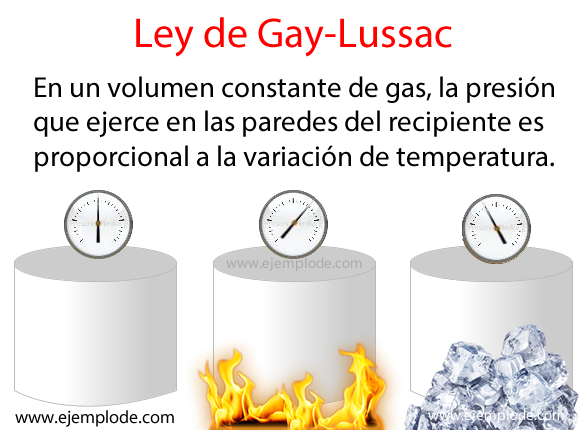Gay-Lussac Law Example
Physics / / November 13, 2021
The French Scientist Louis Joseph de Gay-Lussac He studied the phenomena that happen with a gas, when it is contained in a closed container (fixed volume), and the temperature varies. Gases, from the physical point of view, can be studied from three characteristics that are: volume, which is the space it occupies, and which for experimental purposes is the Volume that fills a container. The pressure, which is the force that the gas exerts on the walls of the container and also the force that can be applied to the gas, for example, by means of a piston. The third characteristic is the temperature, since gases increase their movement when the temperature increases and when it decreases, their movement also decreases.
As a result of his observations, he realized that having a certain volume of gas and this is not varied throughout the experiment, heating the mass of gas increases its kinetic energy, its molecules begin to move away from each other and the mass of gas expands, which has as a consequence that the pressure that the gas makes on the walls of the container. He also observed that as the temperature decreases, the kinetic energy of the gas decreases and the pressure it exerts on the container walls decreases. This is summarized in the call
Gay Lussac's Law:
The pressure exerted by a fixed volume of gas on the walls of the container that contains it is directly proportional to the variation in temperature.
In Gay-Lussac's law, for a given volume of gas, there is always the same relationship between its pressure and its temperature, that is, this relationship is always constant. This is expressed by the following formula:
P / T = k
P1/ T1 = P2/ T2 = k
P, P1, P2 = The pressure of the gas, which can be expressed in atmospheres (at) or in grams per square centimeter (g / cm2)
T, T1, T2 = It is the temperature of the gas, which can be expressed in degrees centigrade (° C) or degrees on the scale of absolute zero or degrees Kelvin (° K)
k = is the constant of the pressure and temperature relationship for that particular volume of gas.
From this formula, the values of its components can be solved:
P / T = k
T = P / k
P = T * k
3 applied examples of Gay-Lussac's law:
1. A container contains a volume of gas that is at a pressure of 1.2 at, at an ambient temperature of 22 ° C at 10 in the morning. Calculate the pressure that the gas will have when the temperature rises to 28 ° C at noon
P1 = 1.2 at
T1 = 22 ° C
P2 = ?
T2 = 28 ° C
First we calculate the constant of that gas:
P1/ T1 = P2/ T2 = k
1.2 / 22 = 0.0545
Now we solve for the value of P2:
P2 = T2* k = (28) (0.0545) = 1.526 at
So at noon, the pressure will be 1,526 atmospheres.
2. A container contains a volume of gas that is at a pressure of 25 g / cm2, at an ambient temperature of 24 ° C. Calculate the pressure that the gas will have when its temperature decreases by 18 ° C.
P1 = 25 g / cm2
T1 = 24 ° C
P2 = ?
T2 = (24-18) = 6 ° C
First we calculate the constant of that gas:
P1/ T1 = P2/ T2 = k
25 / 24 = 1.0416
Now we solve for the value of P2:
P2 = T2* k = (6) (1.0416) = 6.25 g / cm2
By reducing the temperature 18 ° C, the final temperature will be 6 ° C and the pressure will be 6.25 g / cm2.
3. Calculate the initial temperature of a volume of gas, if we know that its initial pressure was 3.5 at, and when it reaches 67 ° C its pressure is 16.75 at.
P1 = 3.5 at
T1 = ?
P2 = 16.75 at
T2 = 67 ° C
First we calculate the constant of that gas:
P1/ T1 = P2/ T2 = k
16.75 / 67 = 0.25
Now we solve for the value of T1:
T1 = P1/ k = (3.5) / (0.25) = 14 ° C
The initial temperature was 14 ° C.


